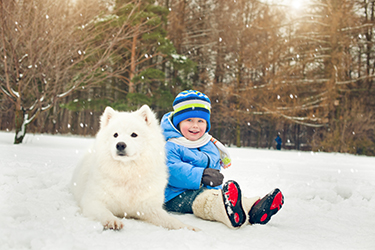Frostbite in Dogs and Cats

Winter Weather Danger: Frostbite Isn’t Just for Humans
Winter weather can be dangerous for both humans and animals. Dogs and cats are susceptible to frostbite, even with their thick fur coats. The easiest way to prevent frostbite for your pet is to keep them indoors. They should not be outside in the cold weather for a long period without shelter. Dogs can wear jackets, sweaters and boots to help prevent frostbite.
Preventative care will guard your dog’s paws against snow build-up so his paws stay healthy. Keep his paw hair clipped short, so it is even with the pad. Trim your dog’s nails year-round, but even more so in the winter because long nails force the paw to splay out and make it more likely that snow and ice will accumulate. Apply a thin layer of a protective balm, such as Vaseline, before your dog goes outside. Use a warm washcloth to remove snow, ice and ice melt when he comes inside. This regimen will guard your dog against frostbite on his feet.
What is Frostbite?
Frostbite results from prolonged exposure to severe cold, and can occur on the tips of the ears, nose, tail, paws or any area where the hair is thin. If frostbite is not treated immediately, your pet may lose the affected area. Dogs or cats with frostbite are likely suffering from hypothermia, or low body temperature too, so watch your pet for shivering, anxiety or moving slowly.
Areas affected by frostbite will be pale to bluish white in color and much cooler to the touch than the surrounding skin because of loss of circulation to the area. Ice may form. If circulation returns, the area will be red and swollen and it may peel and become painful. As frostbite in a dog progresses, the area becomes blackened.
How Do You Treat a Dog for Frostbite?
- Warm a towel on a radiator, clothes dryer or using a handheld hair dryer. Do not directly warm the dog with the hair dryer or other heat source.
- Apply the warm towel to the affected areas. Do not squeeze or rub hard, as this can cause more damage. Do not warm an affected area unless you are able to keep the area warmed.
- Use tepid water to warm up the affected areas to a temperature of 100°F (32°C), but no higher than 108°F, as this can cause more damage.
- As the areas thaw, they will redden. If they become dark instead, seek immediate veterinary attention.
Your dog may require pain medication, antibiotics, fluids and a warming environment. In some extreme cases, if the affected area is large enough, amputation may be necessary. Most cases of frostbite are mild and resolve with only cosmetic damage.
How Do You Treat a Cat for Frostbite?
- Warm the skin and stimulate the return of circulation to the affected area with warm (not hot), moist heat. This can be accomplished by immersing the area in warm water for 15 to 30 minutes or applying a warm moist towel to the area.
- DO NOT rub the area as it will cause more damage.
- As the circulation returns, the skin will redden.
- Apply aloe vera to the skin.
- If any of the red areas start turning dark, it is a sign of severe tissue damage and your cat should be seen by a veterinarian immediately.
Even if you’ve treated your pet successfully at home, you should seek veterinary attention to make sure there is no other damage and that no additional treatment is required. As the area heals, it may become itchy so it’s important to keep your pet from licking, chewing or scratching it. If the tissue has died, it will need to be removed surgically.
Covetrus North America is dedicated to advancing the world of veterinary medicine. Visit us online or contact your Covetrus representative at 855.724.3461.
Sources:
https://www.petmd.com/dog/emergency/common-emergencies/e_dg_frostbite
https://www.petmd.com/cat/emergency/common-emergencies/e_ct_frostbite
http://www.pethealthnetwork.com/dog-health/dog-diseases-conditions-a-z/frostbite-cats-and-dogs
https://www.cesarsway.com/winter-proofing-your-dogs-paws/
http://www.pethealthnetwork.com/dog-health/dog-diseases-conditions-a-z/hypothermia-and-your-pet
Careers
Are you looking for a place to let your talents shine? At Covetrus, we help our practitioner customers better serve their patients and take pride in providing the best customer experience possible. Search our open positions to see our available opportunities.
Newsletter
Stay current with what’s going on with Covetrus, subscribe to receive our newsletter and email communications. Subscribers will receive the latest information in practice management, sales and marketing, animal health, and more.


Leave a comment